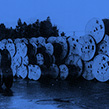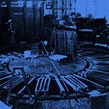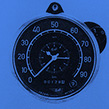Continuous copper casting and rolling machine, Fuji Factory (2014)
Episodes in Yazaki’s development and business growth
This section presents episodes describing Yazaki product development,
through which our predecessors brought wire harnesses and many other flagship products to the world.
HOME Episodes in Yazaki’s development and business growth “LP10”: The gas meter that changed how people think about propane

Gas meter
“LP10”: The gas meter that changed how people think about propane

Coal sold by the sack, gas sold by the cylinder
Propane (LP gas) first came into use as a household fuel in Japan in 1953. This was when sales of 10-kg cylinders (popularly known as “daruma”) for household use began. LP gas made its first appearance (at 5%) in the Ministry of International Trade and Industry’s survey of household energy demand component ratios in 1961, which indicates that LP gas was finally seeing a rapid increase in popularity at this time. In those days, LP gas was like coal, charcoal and firewood in that it was handled by fuel supply stores. And like coal, which was sold by the bag, and firewood, which was sold by the bundle, stores sold LP gas for a certain amount per cylinder and then delivered it to the household. However, because no system existed to measure the amount of gas that remained in a cylinder, consumers always had the nagging suspicion that a lot of gas might be left inside. On the other hand, things were not easy for the fuel supply stores either. They had to handle a relentless flow of orders around the clock and be ready to move whenever a customer called up and said, “I’m out of gas. Bring more now!” It was against this backdrop that Yazaki began marketing the LP10, the first LP gas meter to be sold in Japan, in 1963.
A parade of executives to gas stores
The LP10 used a turbine wheel to measure only the amount of gas that was used. Gas escaping from the cylinder rotated the turbine wheel. The meter then added up the amount of flowing gas. To prevent unexpected gas outages, it also had a knob that turned red when the gas was running low. With the LP10, Yazaki began a PR strategy aimed at stores handling propane gas throughout Japan. The strategy’s catchphrase was “Buy and use gas with peace of mind.”
However, the old business practice of selling propane one cylinder at a time was a stubborn one. On top of that, gas stores were stuck with the cost of the gas meters. Yazaki personnel, even executives, went from gas store to gas store with sample LP10s in hand. What finally won over the stores was the fact that the meter gave them a life free of those dreaded calls for more gas that could come at any time—24 hours a day, 365 days a year. It could also wipe away customers’ suspicions about remaining gas. Other powerful forces that helped promote the meter included the women of the Japan Housewives' Association*1 and National Federation of Regional Women’s Organizations.*2 They put pressure on the Ministry of International Trade and Industry to install meters, and as a result, a new LP Gas Act was enacted, and a system for sales of LP gas meters was established in 1967.
The behind-the-scenes force that prompted a corporate name change
In 1965, just prior to the enactment of the new LP Gas Act, Yazaki began marketing a more advanced diaphragm gas meter called the “V2.” Later, sales of this new product suddenly took off, boosted by the effects of the new act. Yazaki subsequently continued to place new products on the market, namely the “Micom Gas Meter II ” and “U-Smart” ultrasonic gas meter. Yazaki continues to hold a sizeable share of the gas meter market even today.
In fact, 1963, the year that sales of the LP10 began, was also the year that Yazaki changed its corporate name from Densen Kogyo to Yazaki Corporation. This change was made in anticipation of a broader business focus that would include products in the energy and living environment fields. The behind-the-scenes force that pushed the name change forward was the LP10.
*1… Formed in 1948, the Japan Housewives’ Association is comprised of consumer groups and individual members who work to reflect housewives’ views on politics and society and to protect consumer interests.
*2… The National Federation of Regional Women’s Organizations is a national body of regional women’s organizations that works to raise the status of women and improve family life and community living, among other activities.
EPISODE SELECTION
EPISODE 01 Aroace: Overcoming obstacles buoyed on the founder’s adventurous spirit
EPISODE 02 The egg lays the chicken: The secret story behind the birth of the wire harness
EPISODE 03 A drum business that conserves valuable wood resources and recycles waste plastic
EPISODE 04 “LP10”: The gas meter that changed how people think about propane
EPISODE 05 Moving toward a sustainable future as a pioneer in the use of solar heat
EPISODE 07 From the quagmire of labor dispute rose the grand flower of the meter
EPISODE SELECTION















